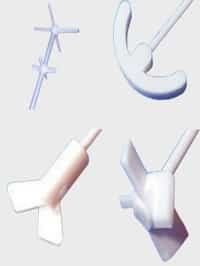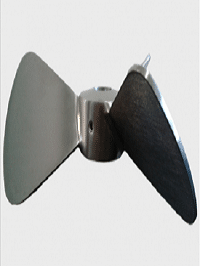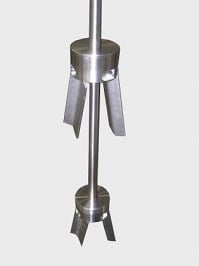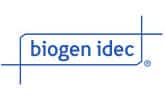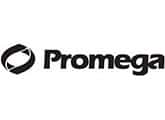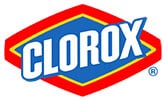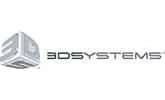Industrial & Sanitary Mixing Impellers
Mixers used in the food, beverage, dairy, chemical and pharmaceutical industries are required to mix fluids and non-Newtonian fluids, to emulsify immiscible liquids, to disperse solids or gases into liquids and to mix solids. Each operation has a specific degree of agitation necessary to obtain the desired result. It is therefore dependent upon the agitator in the mixing system, a component that typically consists of a drive assembly, a shaft and an impeller (also referred to in the process industries as a propeller, a paddle, a turbine or a hydrofoil). The impeller converts the rotational energy of the shaft into a combination of axial, radial or tangential flow, shear and turbulence. There are many designs of impellers available commercially and no one design is capable of providing optimum performance under every set of conditions in the many mixing processes being used today. Furthermore, a magic formula for selecting the optimum impeller design for a particular mixing process does not exist. However, there are several questions that one can ask when selecting an impeller:
What flow pattern is required (flow vs shear required)? What types of impeller are available and costs involved? What mixing vessel is being used and volumes being blended? What type of mixing process is involved and desired mixing results?
To readily access vessels with narrow necks, e.g., carboys, a folding mixing impeller is commercially available. This mixing impeller has two blades attached to the shaft and the blades fold together to allow installation of the agitator. Folding props, or drum bung mixer propellers are suited for 55gal drum mixing and carboys with small openings to fit the mixing impeller. For more general industrial and sanitary mixing applications the plastic or Teflon shaft and impellers are used which are very corrosion resistant and easy to clean.
The accumulation of material on the walls of the mixing tank or vessel can be a problem in some mixing processes and can reduce the efficiency of heat transfer to or from the walls. To overcome this problem, the vessel walls are continuously scraped by flexible, hinged scrapers attached to the outer edges of the blades of the impeller.
Tickler impellers are often used for low level mixing and designed to provide enough flow while draining vessels or making up very small volumes. Impellers can also be used for up-pumping in customized applications.
Materials of Construction and Sanitary Requirements
Stainless steel alloys are widely used to fabricate impellers, providing excellent resistance to corrosion and therefore minimizing contamination of the materials being processed. The concern for purity in the food, dairy, beverage and pharmaceutical industries is reflected in the demand for smooth surfaces, particularly the surfaces that contact the fluids being used. Surface smoothness can significantly reduce localized corrosion processes and the stainless steels can be smoothed by either mechanical or chemical treatments or by electropolishing. Surface scale and discoloration that appears after heat treatments can be removed by chemical treatments. For high purity requirements electropolishing not only offers the advantage of being versatile, but provides a very smooth surface that is readily passivated.
Teflon impellers are commercially available today and stainless steel shafts can easily be clad with a layer of the fluoropolymer. The hydrophobic nature of the surfaces results in less build-up of material on the impeller and shaft. Several types of stainless steel impellers can be coated with Teflon if necessary.
Mixing impellers for biotech applications often are 316Lss, welded to the shaft, polished to ‹20RA, and then passivated and electropolished. Impellers should also be self-draining and capable of being cleaned via CIP and SIP. Biopharm mixing impellers would typically be fabricated rather than cast to provide for a pit free polished finish. Material test reports on the 316Lss or material of construction are often required.
In addition to the sanitary nature of the mixing impeller, other options are available from various manufacturers. Ringuard or shroud for the impeller are used especially when mixing with bag liners in the drum. Mixing prop stabilizer or stabilizing rings are used to enhance the mechanical stability of the shaft/impeller system and help with fill up and draw down.
Careful consideration should be taken to assure the impeller provides the right flow, shear, mixing action while also being mechanically sound for mixer critical speed and bending moments.
The Design and Dimensions of the Mixing Vessel
The geometry of the mixing vessel, in terms of the aspect ratio and the shape of the bottom, should not be overlooked. Dish-bottomed vessels are preferred, although flat-bottomed or shallow cone (‹15�) can be used without particular problems. The ratio of the depth of fluid to the diameter of the vessel (the aspect ratio) should be unity or close to unity. The position of the impeller within the process fluid can also affect performance. Incorrect location of either single or multiple impellers can result in staged flow patterns and non-uniform distribution of added materials. Mixing vessels are often fitted with baffles, these being stationary elements located at or near the walls. Baffles tend to inhibit liquid swirl and therefore minimize tangential flow, allowing axial flow patterns to develop.
The dimensions of the mixing vessel must be considered when selecting the size and shape of the impeller. The ratio of the diameter of the impeller to that of the mixing vessel should range from 0.2 to 0.5, i.e., 0.2 ‹ D/T ‹ 0.5, where D is the diameter of the impeller and T is that of the vessel. The distance from the impeller to the bottom of the vessel (the clearance, C) affects the power draw and pumping efficiency of the mixer. For optimum performance the ratio C/T should range from 0.1 to 0.3, although hydrofoils operate with C/T approximately 0.5
Impeller positioning in the tank should be considered as there are a number of ways to orient the shaft/impeller to achieve the mixing results. Number of impellers is also a consideration depending on mixing volumes.
How to Specify the Mixing Impeller
Some of the information your mixing vendor will require: What is your desired mixing results. What are you mixing. Volume you are mixing. Tank dimensions. High and low liquid levels. Mixture Viscosity, SG or Density, Solids %. Impeller diameter, shaft size for bore. Mixer speed range. HP available. How secure impeller to shaft. Materials of construction and documentation required. Surface finish Polish. Coatings, electropolish, EP. Impeller style desired. A general conversation on what is desired and all the process and mechanical information for the mixing application will help a vendor provide assistance in selecting the right impeller for the job.
Mixing Processes
Mixing includes the blending of miscible liquids, the dispersion of liquids, gases and solids, the emulsification of immiscible liquids, the formation of solid suspensions, dissolution and crystallization processes, chemical reactions that are dependent upon mass transfer and heat transfer into and out of the vessel. The choice of an impeller should be determined in part by the particular mixing process. Dispersion to form slurries will require a different impeller to that required to form pastes. Crystallization processes may involve crystals that are easily fractured and require gentle agitation. Other crystals tend to form at the walls of the vessel and scrapers may be required.
Whether you are choosing a mixing impeller for scale down, scale up, R+D, or bench scale pilot, testing one should look at all the options available to choose the right impeller at the right economy for your particular project.
It is evident that the selection of an impeller for a mixing process in the food and beverage, dairy, pharmaceutical and chemical industries is not a simple matter. The impellers come in a variety of shapes and sizes and optimum performance is dependent upon several factors — the physical properties of the materials to be mixed, the type of mixing process, the mixing vessel and the generation of the correct flow, shear and turbulence. Mixing is considered by many to be an art and, without question, “hands on” experience becomes very important when selecting mixers and impellers. That experience likely resides with the manufacturers of mixing equipment and with their representatives.
What Do You Know About Mixing Flow?
Understanding flow patterns is an important part of helping you choose the right impeller. The three primary types of flow patterns are described below
Axial Mixing Flow
The fluid parallel to an axis of rotation. It moves media from the top to the bottom. Axial flow impellers are used for blending, solids suspension, solids incorporation or draw down. It is most common in a low viscosity, high speed application. The most common impeller style is the propeller.
Radial Mixing Flow
The fluid is discharged radially outward to the vessel wall. Compared to axial flow impellers, radial flow impellers provide higher shear and turbulence levels with lower pumping. Radial flow draws the media from the top and bottom. They are used for liquid dispersion for low to medium viscosity fluids and high speed. The most common impeller styles are the straight blade and crossed blade.
Tangential Mixing Flow
The flow pattern seen when tangential or rotational flow dominates is a swirling of the tank contents, often with a surface vortex. It is often used when mixing high viscosity at lower speeds. The most common impeller styles are the U-shaped anchor and square blade impeller.

